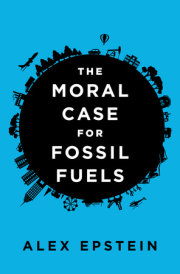1THE SECRET HISTORY OF FOSSIL FUELS
“YOU MUST MAKE A LOT OF MONEY”
“You’re an environmentalist, right?” the girl, college age, asked me. It was 2009, in Irvine, California. I had stopped at a farmers’ market near my office for lunch, and she was manning a Greenpeace booth right next to it.
“Do you want to help us end our addiction to dirty fossil fuels and use clean, renewable energy instead?”
“Actually,” I replied, “I study energy for a living—and I think it’s good that we use a lot of fossil fuels. I think the world would be a much better place if people used a lot more.”
I was curious to see how she would respond—I doubted she had ever met anyone who believed we should use more fossil fuels. I was hoping that she would bring up one of the popular arguments for dramatically reducing fossil fuel use, and I could share with her why I thought the benefits of using fossil fuels far outweighed the risks.
But fossil fuels cause climate change, she might have said. I agree, I would have replied, but I think the evidence shows that climate change, natural or man-made, is more manageable than ever, because human beings are so good at adapting, using ingenuity and technology.
But fossil fuels cause pollution, she might have said. I agree, I would have replied, but I think the evidence shows that ingenuity and technology make pollution a smaller problem every year.
But fossil fuels are nonrenewable, she might have said. I agree, I would have replied, but I think the evidence shows that there are huge amounts of fossil fuels left, and we’ll have plenty of time to use ingenuity and technology to find something cheaper—such as some form of advanced nuclear power.
But fossil fuels are replaceable by solar and wind, she might have said. I disagree, I would have replied, because the sun and the wind are intermittent, unreliable fuels that always need backup from a reliable source of energy—usually fossil fuels, which is the only source of energy that has been able to provide cheap, plentiful, reliable energy for the billions of people whose lives depend on it.
But she didn’t say any of those things. Instead, when I said I thought that we should use more fossil fuels, she looked at me with wide-eyed disbelief and said, “Wow, you must make a lot of money.”
In other words, the only conceivable reason I would say that our use of fossil fuels is a good thing is if I had been paid off by the fossil fuel industry.
Even though this wasn’t true, I understood why she thought it. It is conventional wisdom that our use of fossil fuels is an “addiction”—a short-range, unsustainable, destructive habit.
Eighty-seven percent of the energy mankind uses every second, including most of the energy I am using as I write this, comes from burning one of the fossil fuels: coal, oil, or natural gas.1 Every time someone uses a machine—whether the computer I am using right now, the factory it was produced in, the trucks and ships that transported it, the furnace that forged the aluminum, the farm equipment that fed all the workers who made it, or the electricity that keeps their lights on, their phones charged, and their restaurants and hospitals open—they are using energy that they must be able to rely on and afford. And 87 percent of the time, that energy comes from coal, oil, or natural gas.2 Without exception, anyone who lives a modern life is directly or indirectly using large amounts of fossil fuel energy—it is that ubiquitous.
But, we are told, this cannot continue.
While it might be convenient to drive gasoline cars and get electricity from coal in the short run, and while we might have needed them in the past, the argument goes, in the long run we are making our climate unlivable, destroying our environment, and depleting our resources. We must and can replace fossil fuels with renewable, green, climate-friendly energy from solar, wind, and biomass (plants).
This is not a liberal view or a conservative view; it’s a view that almost everyone holds in one form or another. Even fossil fuel companies make statements like the one the former CEO of Shell made in 2013: “We believe climate change is real and time is running out to take real action to reduce greenhouse gas emissions.”3 President George W. Bush was the person who popularized the expression “addicted to oil.”4 The debate over our addiction to fossil fuels is usually over how dangerous the addiction is and how quickly we can get rid of it—not whether we have one.
And the most prominent groups say we must get rid of it very quickly.
For years, the Nobel Prize–winning Intergovernmental Panel on Climate Change (IPCC) has demanded that the United States and other industrialized countries cut carbon dioxide emissions to 20 percent of 1990 levels by 2050—and the United States has joined hundreds of other countries in agreeing to this goal.5
Every day, we hear of new predictions from prestigious experts reinforcing the calls for massive restrictions on fossil fuel use. As I write this, news about melting ice in West Antarctica is leading to dire predictions of sea level rises: “Scientists Warn of Rising Oceans from Polar Melt,” reports the New York Times; “Is It Too Late to Save Our Cities from Sea-Level Rise?” asks Newsweek, citing new research that “Miami and Manhattan will drown sooner than we thought.”6
The message is clear: Our use of fossil fuels is going to destroy us in the long run, and we should focus our efforts on dramatically reducing it as soon as humanly possible.
So when the girl at the Greenpeace booth implied that I had sold my soul, I didn’t get offended. I simply explained that, no, I wasn’t being paid off; I had just concluded, based on my research, that the short- and long-term benefits of using fossil fuels actually far, far outweigh the risks and was happy to explain why. But she wasn’t interested. Pointing me to the Greenpeace pamphlets giving all the reasons fossil fuels are bad, she said, “So many experts predict that using fossil fuels is going to lead to catastrophe—why should I listen to you?” She made it clear that this wasn’t a real question and that the conversation was over.
But if she had wanted an answer, I would have told her this: I understand that a lot of smart people are predicting catastrophic consequences from using fossil fuels, I take that very seriously, and I have studied their predictions extensively.
And what I have found is this: leading experts and the media have been making the exact same predictions for more than thirty years. As far back as the 1970s they predicted that if we did not dramatically reduce fossil fuel use then, and use renewables instead, we would be experiencing catastrophe today—catastrophic resource depletion, catastrophic pollution, and catastrophic climate change. Instead, the exact opposite happened. Instead of using a lot less fossil fuel energy, we used a lot more—but instead of long-term catastrophe, we have experienced dramatic, long-term improvement in every aspect of life, including environmental quality. The risks and side effects of using fossil fuels declined while the benefits—cheap, reliable energy and everything it brings—expanded to billions more people.
This is the secret history of fossil fuels. It changed the way I think about fossil fuels and it may change the way you think about them, too.
DÉJÀ VU
When I was twenty years old, I decided I wanted to write about “practical philosophy” for a living. Philosophy is the study of the basic principles of clear thinking and moral action. While college philosophy classes all too often present philosophy as an impractical subject that involves endlessly debating skeptical questions (“How do you know you exist?” “How do you know you’re not in The Matrix?”), philosophy is in fact an incredibly practical tool. No matter what we’re doing in life, whether we’re coming up with a business plan or raising children or deciding what to do about fossil fuels, it is always valuable to be able to think clearly about what is right and what is wrong and why.
One valuable lesson philosophy taught me is that with any idea, such as the idea that we need to get off fossil fuels, we should look at the track record of that idea, if it has one.
Now, you might think: this idea does not have a history because it is a new idea based on the latest science. This is certainly the impression many of our leading intellectuals give. For example, in 2012 I debated Bill McKibben, the world’s leading opponent of fossil fuels, at Duke University, and he presented his view of our addiction to fossil fuels as cutting-edge: “We should be grateful for the role that fossil fuel played in creating our world and equally grateful that scientists now give us ample warning of its new risks, and engineers increasingly provide us with the alternatives that we need.”7 This is the narrative we hear over and over: fossil fuels were once necessary, but the latest science tells us they’re causing an imminent catastrophe unless we stop using them and replace them with cutting-edge renewables.
What is rarely mentioned is that thirty years ago, leading experts, including many of today’s leading experts, were telling us that fossil fuels were once necessary, but the latest science tells us they’re causing an imminent catastrophe unless we stop using them and replace them with cutting-edge renewables.
Take the prediction we hear today that we will soon run out of fossil fuels—particularly oil—because they are nonrenewable. This prediction was made over and over by some of the most prestigious thinkers of the 1970s, who assured us that their predictions were backed by the best science.
In 1972, the international think tank the Club of Rome released a multimillion-copy-selling book, The Limits to Growth, which declared that its state-of-the-art computer models had demonstrated that we would run out of oil by 1992 and natural gas by 1993 (and, for good measure, gold, mercury, silver, tin, zinc, and lead by 1993 at the latest).8 The leading resource theorist of the time was ecologist Paul Ehrlich, who was so popular and prestigious that Johnny Carson invited him onto his show over a dozen times. In 1971 he said, “By the year 2000 the United Kingdom will be simply a small group of impoverished islands, inhabited by some 70 million hungry people,”9 and in 1974 he wrote, “America’s economic joyride is coming to an end: there will be no more cheap, abundant energy, no more cheap abundant food.”10
Another catastrophic prediction we hear today is that pollution from fossil fuels will make our environment more and more hazardous to our health—hence we need to stop using “dirty” fossil fuels. This prediction was also made many times in the 1970s—with many assurances that these predictions were backed by the best science.
Life magazine reported in January 1970 that, because of particles emitted in the air by burning fossil fuels, “Scientists have solid experimental and theoretical evidence to support . . . the following predictions: In a decade, urban dwellers will have to wear gas masks to survive air pollution . . . by 1985 air pollution will have reduced the amount of sunlight reaching earth by one half . . .”11 To quote Paul Ehrlich again, as he may have been the most influential public intellectual of the decade (and is still a prestigious professor of ecology at Stanford University): “Air pollution . . . is certainly going to take hundreds of thousands of lives in the next few years alone,” he said in 1970.12
And then there’s the prediction we hear most today: the supposedly scientifically indisputable claim that CO2 emissions from fossil fuels will cause a true climate catastrophe within a couple of decades.13 Reading back in time, I saw that many of the leaders who make that prediction now had, decades ago, predicted that we’d be living in catastrophe today.
Here’s a 1986 news story about a prediction by James Hansen, the most influential climate scientist in the world over the last thirty years:
Dr. James E. Hansen of the Goddard Space Flight Center’s Institute for Space Studies said research by his institute showed that because of the “greenhouse effect” that results when gases prevent heat from escaping the earth’s atmosphere, global temperatures would rise early in the next century to “well above any level experienced in the past 100,000 years.”
Average global temperatures would rise by one-half a degree to one degree Fahrenheit from 1990 to 2000 if current trends are unchanged, according to Dr. Hansen’s findings. Dr. Hansen said the global temperature would rise by another 2 to 4 degrees in the following decade.14
Bill McKibben, when he told Duke students in 2012 that we were on the verge of drastic warming, neglected to mention the results of his decades-old claims, such as this one in 1989: “The choice of doing nothing—of continuing to burn ever more oil and coal—is not a choice, in other words. It will lead us, if not straight to hell, then straight to a place with a similar temperature”; and “a few more decades of ungoverned fossil-fuel use and we burn up, to put it bluntly.”15
John Holdren, a protégé of Paul Ehrlich who serves as science adviser to President Barack Obama, had a particularly dire prediction, according to Ehrlich in 1986: “As University of California physicist John Holdren has said, it is possible that carbon-dioxide climate-induced famines could kill as many as a billion people before the year 2020.”16
Just as the media today tell us these catastrophic predictions are a matter of scientific consensus, so did the media of the 1980s. For example, on the issue of catastrophic climate change: “By early 1989 the popular media were declaring that ‘all scientists’ agreed that warming was real and catastrophic in its potential,” a 1992 study reported.17
If all the predicted catastrophes—depletion, pollution, climate change—had occurred as thought leaders said they would, the world of today would be much, much worse than the world of the 1970s. In the 1970s, Ehrlich went as far as to say, of the overall devastation ahead, “If I were a gambler, I would take even money that England will not exist in the year 2000.”18
And these were not idle predictions—the coming fossil fuel catastrophe was so bad, these leading experts said, that we needed dramatic restrictions on fossil fuel energy use. Ehrlich wrote: “Except in special circumstances, all construction of power generating facilities should cease immediately, and power companies should be forbidden to encourage people to use more power. Power is much too cheap. It should certainly be made more expensive and perhaps rationed, in order to reduce its frivolous use.”19
In 1977, Amory Lovins, widely considered the leading energy thinker of the 1970s for his criticisms of fossil fuels and nuclear power and his support of solar power and reduced energy use, explained that we already used too much energy. And in particular, the kind of energy we least needed was . . . electricity, the foundation of the digital/information revolution: “[W]e don’t need any more big electric generating stations. We already have about twice as much electricity as we can use to advantage.”20
In 1998, Bill McKibben endorsed a scenario of outlawing 60 percent of present fossil fuel use to slow catastrophic climate change, even though that would mean, in his words, that “each human being would get to produce 1.69 metric tons of carbon dioxide annually—which would allow you to drive an average American car nine miles a day. By the time the population increased to 8.5 billion, in about 2025, you’d be down to six miles a day. If you carpooled, you’d have about three pounds of CO2 left in your daily ration—enough to run a highly efficient refrigerator. Forget your computer, your TV, your stereo, your stove, your dishwasher, your water heater, your microwave, your water pump, your clock. Forget your light bulbs, compact fluorescent or not.”21
All of these thinkers still advocate similar policies today—in fact, today Bill McKibben endorses a 95 percent ban on fossil fuel use, eight times as severe as the scenario described above!22 And all of them are extremely prestigious. Since making these predictions, John Holdren has become science adviser to President Obama, Bill McKibben is called “the nation’s leading environmentalist”23 and more than anyone led opposition to the Keystone XL pipeline, and Paul Ehrlich is still arguably the most influential ecological thinker in the world. Energy historian Robert Bradley Jr. chronicles his accolades:
Ehrlich held an endowed chair as the Bing Professor of Population Studies in the Biology Department at Stanford and was elected president of the American Institute of Biological Sciences. He was elected to the National Academy of Sciences and received many awards and prizes, including the inaugural prize of the American Academy of Arts and Sciences for Science in the Service of Humanity, a MacArthur Genius Award, the Volvo Environmental Prize, the World Ecology Medal from the International Center for Tropical Ecology, and the International Ecology Institute Prize.
He also received what is hyped as the equivalent of the Nobel Prize in a field where it is not awarded—the Crafoord Prize in Population Biology and the Conservation of Biological Diversity.24
Thus, today’s leading thinkers and leading ideas about fossil fuels have a decades-long track record—and given that they are calling for the abolition of our most popular form of energy, it would be irresponsible not to look at how reality has compared to their predictions.
Of course, predictions on a societal or global level can never be exact, but they need to be somewhere near the truth.
So what happened?
Two things: Instead of following the leading advice and restricting the use of fossil fuels, people around the world nearly doubled their use of fossil fuels—which allegedly should have led to an epic disaster. Rather, it led to an epic improvement in human life across the board.
MORE FOSSIL FUELS, MORE FLOURISHING
Here is a picture summarizing world energy use since 1980.
Figure 1.1: 80 Percent Increase in Worldwide Fossil Fuel Use 1980–2012
Source: BP, Statistical Review of World Energy 2013, Historical data workbook
From the 1970s to the present, fossil fuels have overwhelmingly been the fuel of choice, particularly for developing countries. In the United States between 1980 and 2012, the consumption of oil increased 8.7 percent, the consumption of natural gas increased 28.3 percent, and the consumption of coal increased 12.6 percent.25 During that time period, the world overall increased fossil fuel usage far more than we did. Today the world uses 39 percent more oil, 107 percent more coal, and 131 percent more natural gas than it did in 1980.26
This wasn’t supposed to happen.
The anti–fossil fuel experts had predicted that this would be not only deadly, but unnecessary due to the cutting-edge promise of solar and wind (sound familiar?). Then as now, environmental leaders were arguing that renewable energy combined with conservation—using less energy—was a viable replacement for fossil fuels.
Amory Lovins wrote in 1976: “Recent research suggests that a largely or wholly solar economy can be constructed in the United States with straightforward soft technologies that are now demonstrated and now economic or nearly economic.”27 Lovins was a sensation, and around the globe governments gave solar (and wind and ethanol) companies billions of dollars in the hope that they would be able to generate cheap, plentiful, reliable energy.
But as the last graph illustrates, this did not happen. Solar and wind are a minuscule portion of world energy use. And even that is misleading because fossil fuel energy is reliable whereas solar and wind aren’t. While energy from, say, coal is available on demand so you can keep a refrigerator—or a respirator—on whenever you need it, solar energy is available only when the sun shines and the clouds cooperate, which means it can work only if it’s combined with a reliable source of energy, such as coal, gas, nuclear, or hydro.28
Why did fossil fuel energy outcompete renewable energy—not just for existing energy production but for most new energy production? This trend is too consistent across too many countries to be ignored. The answer is simply that renewable energy couldn’t meet those countries’ energy needs, though fossil fuels could. While many countries wanted solar and wind, and in fact used a lot of their citizens’ money to prop up solar and wind companies, no one could figure out a cost-effective, scalable process to take sunlight and wind, which are dilute and intermittent forms of energy, and turn them into cheap, plentiful, reliable energy.
So despite the warnings of leading experts, people around the world nearly doubled their use of fossil fuels.
According to the predictions of the most popular experts, who assured us that their conclusions reflected the best science, this should have led to utter catastrophe. But the result was one of the greatest-ever improvements in human life.
This book is about morality, about right and wrong. To me, the question of what to do about fossil fuels and any other moral issue comes down to: What will promote human life? What will promote human flourishing—realizing the full potential of life? Colloquially, how do we maximize the years in our life and the life in our years? When we look at the recent past, the past that was supposed to be so disastrous, we should look at flourishing—and that of course includes the quality (or lack thereof) of our environment.
And there is an incredibly strong correlation between fossil fuel use and life expectancy and between fossil fuel use and income, particularly in the rapidly developing parts of the world. Figures 1.2 and 1.3 show recent trends in China and India of fossil fuel use, life expectancy, and income.
There is no perfect measure of flourishing, but one really good measure is life expectancy—the average number of years in the life of a human being. Another good one, for less obvious reasons, is average income. This is valuable because while in a sense “money can’t buy happiness,” it gives us resources and, therefore, time and opportunity to pursue our happiness. It’s hard to be happy when you don’t know where your next meal is coming from. The more opportunity you have to do what you want with your time, the more opportunity you have to be happy.
Consider the fate of two countries that have been responsible for a great deal of the increase in fossil fuel use, China and India. In each country, both coal and oil use increased by at least a factor of 5, producing nearly all their energy.29
Figure 1.2: Fossil Fuel Use and Life Expectancy in China and India
Sources: BP, Statistical Review of World Energy 2013, Historical data workbook; World Bank, World Development Indicators (WDI) Online Data, April 2014
Figure 1.3: Fossil Fuel Use and Income in China and India
Sources: BP, Statistical Review of World Energy 2013, Historical data workbook; World Bank, World Development Indicators (WDI) Online Data, April 2014
The story is clear—both life expectancy and income increased rapidly, meaning that life got better for billions of people in just a few decades. For example, the infant mortality rate has plummeted in both countries—in China by 70 percent, which translates to 66 more children living per 1000 births.30 India has experienced a similar decrease, of 58 percent.
Not only in China and India, but around the world, hundreds of millions of individuals in industrializing countries have gotten their first lightbulb, their first refrigerator, their first decent-paying job, their first year with clean drinking water or a full stomach. To take one particularly wonderful statistic, global malnutrition and undernourishment have plummeted—by 39 percent and 40 percent, respectively, since 1990.31 That means, in a world with a growing population, billions of people are better fed than they would have been just a few decades ago. While there is plenty to criticize in how certain governments have handled industrialization, the big-picture effect has been amazingly positive so far.
Ours is a world that was not supposed to be possible.
• • •
Where did the thinkers go wrong? One thing I have noticed in reading most predictions of doom is that the “experts” almost always focus on the risks of a technology but never the benefits—and on top of that, those who predict the most risk get the most attention from the media and from politicians who want to “do something.”
But there is little to no focus on the benefits of cheap, reliable energy from fossil fuels.
This is a failure to think big picture, to consider all the benefits and all the risks. And the benefits of cheap, reliable energy to power the machines that civilization runs on are enormous. They are just as fundamental to life as food, clothing, shelter, and medical care—indeed, all of these require cheap, reliable energy. By failing to consider the benefits of fossil fuel energy, the experts didn’t anticipate the spectacular benefits that energy brought about in the last thirty years.
At the same time, we do have to consider the risks—including predictions that using fossil fuel energy will lead to catastrophic resource depletion, catastrophic pollution, and catastrophic climate change.
How did those predictions fare? Even if the overall trends are positive, might the anti–fossil fuel experts have been right about catastrophic depletion, catastrophic pollution, and catastrophic climate change, and might those problems still be leading us to long-term catastrophe?
These are important questions to answer.
But when we look at the data, a fascinating fact emerges: As we have used more fossil fuels, our resource situation, our environment situation, and our climate situation have been improving, too.
MORE FOSSIL FUELS, MORE RESOURCES, BETTER ENVIRONMENT, SAFER CLIMATE?
Let’s start with the popular prediction that we’re running out of resources, especially fossil fuels.
If the predictions were right that we were running out of fossil fuel resources, then nearly doubling fossil fuel use worldwide should have practically depleted us of fossil fuels, even faster than Paul Ehrlich and others predicted. That’s certainly what the experts told us in the 1970s. In a 1977 televised address, Jimmy Carter, conveying conventional wisdom at the time, told the nation, “We could use up all of the proven reserves of oil in the entire world by the end of the next decade.”32 A popular Saudi expression at the time captured this idea: “My father rode a camel. I drive a car. My son flies a jet airplane. His son will ride a camel.”33
Well, no one in the oil business is riding a camel, because as fossil fuel use has increased, fossil fuel resources have increased. How is that possible?
The measure for fossil fuel resources is “proven reserves,” which is the amount of coal, oil, or gas that is available to us affordably, given today’s technology. While these statistics are subject to some manipulation—sometimes countries and companies can give misleading data—they are the best information we have and we have historically underpredicted availability.
Let’s look at reserves from 1980 to the present for oil and gas, the fossil fuels we are traditionally afraid will run out. Coal is much easier to find and extract and is considered to be the fossil fuel that is least likely to run out. Notice how the more we consume, the more reserves increase.
Figure 1.4: More Oil Consumption, More Oil Reserves
Source: BP, Statistical Review of World Energy 2013, Historical data workbook
Figure 1.5: More Natural Gas Consumption, More Natural Gas Reserves
Source: BP, Statistical Review of World Energy 2013, Historical data workbook
This is counterintuitive; the more we use, the more we have.
How did this happen? Stay tuned.
Why did so many expect catastrophic depletion? Again, there was a failure to think big picture. Many experts paid attention only to our consumption of oil and gas resources, but not our ability to create new oil and gas resources.
It’s true that once we burn a barrel of oil, it’s gone. But it’s also true that human ingenuity can dramatically increase the amount of coal, oil, or gas that is available. It turns out that there are many times more of each in the ground than we have used in the entire history of civilization—it’s just a matter of developing the technology to extract them economically.34 And in general, human beings are amazingly good at using ingenuity to create wealth, which means to create resources. We take the materials around us and make them more valuable; that’s how we went from starving in a cave to producing a cornucopia of food that we can enjoy in comfortable homes. The thought leaders did not sufficiently consider these virtues of human beings.
What about the prediction that our environment would degrade as we used more fossil fuels and more everything? Our escalating fossil fuel use was definitely supposed to be punished with a much, much dirtier environment.
What actually happened? We’ll look at all major measures of environmental quality in chapter 8, but for now let’s look at clean air and clean water. Both have increased substantially.
Here are measurements from the EPA of six major air pollutants. As fossil fuel use goes up, they go down.
Figure 1.6: U.S. Air Pollution Goes Down Despite Increasing Fossil Fuel Use
Source: U.S. EPA National Emissions Inventory Air Pollutant Emissions Trends Data
And here are international data for the percentage of people in the world with good water quality, which has gone up dramatically in the last 25 years as countries have used more and more fossil fuels.
Figure 1.7: More Fossil Fuels, More Clean Water
Sources: BP, Statistical Review of World Energy 2013, Historical data workbook; World Bank, World Development Indicators (WDI) Online Data, April 2014
Overall, the improvement is incredible. Of course, there are places such as China that have high levels of smog—but the track record of the rest of the world indicates that this can be corrected while using ever increasing amounts of fossil fuels.
Once again, the anti–fossil fuel experts got it completely wrong. Why?
Again by not thinking big picture, by paying attention to only one half of the equation—in the case of fossil fuels, focusing only on the ways in which using them can harm our environment. But fossil fuels, as we’ll discuss in chapter 6, can also improve our environment by powering machines that clean up nature’s health hazards, such as water purification plants that protect us from naturally contaminated water and sanitation systems that protect us from natural disease and animal waste. Pessimistic predictions often assume that our environment is perfect until humans mess it up; they don’t consider the possibility that we could improve our environment. But the data of the last forty years indicate that we have been doing exactly that—using fossil fuels.
Finally, we have to look at what the trend is in the realm of climate change. Catastrophic climate change is the most dire claim about fossil fuels today, and it is associated with many prominent scientific bodies, journals, and media outlets—although if we go through the writings of the 1970s and 1980s, we see those same bodies declare many things confidently about global cooling only to contradict themselves several years later. In 1975, the American Meteorological Society told Americans that the climate was cooling and that this meant worse weather: “Regardless of long term trends, such as the return of an Ice Age, unsettled weather conditions now appear more likely than those of the abnormally favorable period which ended in 1972.”35 In 1975, Nature said, “A recent flurry of papers has provided further evidence for the belief that the Earth is cooling. There now seems little doubt that changes over the past few years are more than a minor statistical fluctuation.”36
Copyright © 2014 by Alex Epstein. All rights reserved. No part of this excerpt may be reproduced or reprinted without permission in writing from the publisher.








